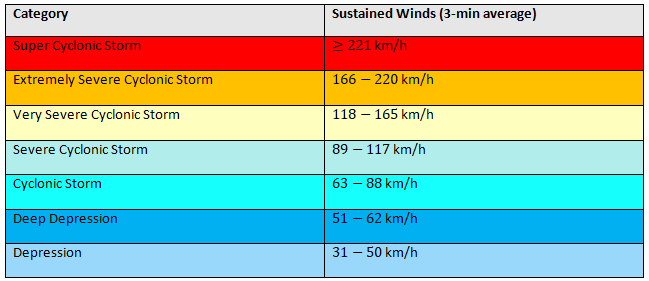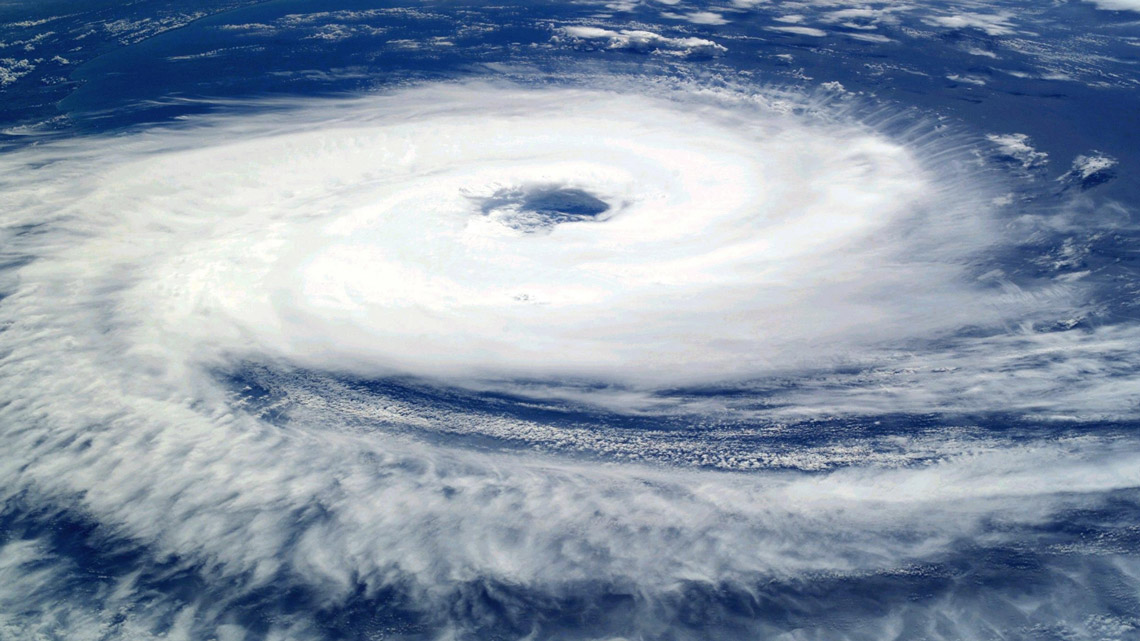Key messages >>>
- Observational trends show an increase in the frequency and intensity of extreme weather events such as tropical cyclones, heavy rainfall events, and marine heat waves, in recent decades that are threatening India’s holistic maritime security.
- Such events typically result in heavy socio-economic losses in terms of damage to infrastructure, damage to natural ecosystems, damage to agricultural crops, and, loss of life, over a short period of time.
- Extreme events directly impact the individual states that bear the full brunt of the immediate damages but, when taken in aggregate, increasingly frequent extreme-weather-shocks pose a monumental threat to the security of the country as a whole.
- India must enhance resilience of new and existing infrastructure against extreme weather in order to limit economic losses. They must also improve weather-forecasting and emergency surveillance services to provide real-time information on extreme events in a way that is accurate, efficient, and easily accessible.
Introduction
The phenomenon of climate change has several significant and serious socio-economic implications for all nations around the world, largely because most of our activities have historically evolved around a relatively stable climate over nearly the past 20,000 years. Since the climate is now changing at an accelerating pace, it is threatening the very foundation of our civilizations, posing a serious threat to national and global security.
Against this backdrop, the National Maritime Foundation (NMF) ais engaged in a major research endeavor to study the impacts of climate change on India’s holistic maritime security. In an initial effort at sensitizing policy-makers, policy-shapers, academia, and the public at large, and in an attempt to provide and disseminate requisite baseline-information on this critical issue, the NMF intends to place in the public domain, a series of articles that will address at least some of the key security-risks posed by climate change and the attendant vulnerabilities in India’s maritime domain. The first article in the series, which was published on the NMF’s website on 22 June 2020, focused entirely on climate-change-induced sea-level rise, and its implications for maritime security. The present article constitutes the second part of the series and seeks to address the ever-growing but under-acknowledged security-threat of intensifying extreme-weather across India, and, to discuss the steps we must take to brace for the ‘super storms’ of the future.
The terms ‘global warming’ and ‘climate change’ are often, but quite incorrectly nevertheless, used interchangeably in media-driven public discourse. ‘Global warming’, in the present context, refers to the ongoing rise in global average temperature due to the increasing concentration of greenhouse gases in the atmosphere, primarily driven by human activities. Rising planetary temperature subsequently alters the fundamental natural cycles of our planet. The broader term, ‘climate change’, describes the long-term changes in the air and ocean such as circulation patterns, hydrological cycle, carbon cycle, and weather patterns, that define the local, regional, and global climates, and is a consequence of rising global average temperature (global warming).
‘Weather’ and ‘Climate’
It is often easily forgotten that weather and climate, although closely related, are not one and the same thing. ‘Weather’, at any given time, describes the atmospheric conditions at that particular time in a particular location. It can change significantly over a period of minutes to hours or days, or across a distance of a few meters to several kilometers. ‘Climate’, on the other hand, refers to the long-term regional or global average of “weather conditions” such as temperature, humidity, and rainfall patterns, over seasons, years, or decades. In the scientific community studying anthropogenic climate change, the “climate” of a region refers to decadal-scale averages of weather, usually over three decades. In other words, ‘climate’ encompasses ‘weather’.
A region’s climate determines the types of weather one can expect, depending on the time of the year. Each weather event has a ‘probability’ (likelihood of occurrence) associated with it. For instance, India has a hot and humid tropical climate; in the summer months (April-June), it is highly likely that the Indo-Gangetic Plains of India will experience very hot daily temperatures in the range of 30°-40° C. During a heatwave, however, which would be classified as an ‘extreme weather event’, temperatures could reach up to 45°-50° C in some parts of the Indo-Gangetic plain. An ‘extreme weather event’, therefore, refers to atmospheric conditions that are outside the typical range of near-average conditions expected for a particular climate type, at a particular time. A heatwave in the Arctic, for instance, would constitute sustained temperatures of say, around 20° C, which would be considered “extreme” for the Arctic climate. Now, due to global warming, as the average temperature (which determines average weather conditions and in turn, the climate) is rising, the entire distribution of possible temperatures (or weather conditions) is changing along with it. Consequently, what used to be ‘extreme’ and low-probability events in the past are becoming increasingly common, and the extremes that previously did not exist are now showing up as ‘extreme’ and rare events.
Changing Odds of Extremes
In recent years, a growing number of peer-reviewed scientific studies have shown that climate change is altering the probability of extreme weather events worldwide. According to a report released in July of 2020 by the Ministry of Earth Sciences of the Government of India, titled “Assessment of Climate Change over the Indian Region”, there has been a decrease in the overall annual-frequency of tropical cyclones in the North Indian Ocean since the middle of last century (1951-2018). However, the report adds that “the frequency of very severe cyclonic storms (VSCSs) during the post-monsoon season has increased significantly (+1 event per decade) during the last two decades (2000-2018).” Observational trends also show an increase in the frequency of Extremely Severe Cyclonic Storms (ESCSs) in the post-monsoon season over the Arabian Sea during 1998-2018. Table 1 shows the different categories of Tropical Revolving Storms’ (TRS) or as they are known in India and its environs, ‘cyclones’, as defined by the Indian Meteorological Department. A cyclone with sustained winds of 118-165 km/h is known as a ‘Very Severe Cyclonic Storm’, while a cyclone with sustained winds of 166-220 km/h is called an ‘Extremely Severe Cyclonic Storm’. Climate-models-based projections suggest that the frequency and severity of tropical cyclones will increase in the future, largely due to anthropogenic climate change, particularly for the more extreme cyclonic storms (VSCSs and higher).
Table 1: Topical Cyclone Intensity Scale

Source: Indian Meteorological Department
Observational records of annual maximum precipitation and number of extreme events show that the frequency and intensity of extreme rainfall events over India, which often lead to floods, have increased during the last few decades. The changes are found to be more dramatic in Southern India compared to Northern India. This trend is expected to continue throughout the 21st century. At the most basic scientific level, this is an expected consequence of increasing atmospheric temperatures, because warm air holds more moisture (with every 1° C increase in temperature, the air can hold around 7 per cent more water vapor). It follows that nowadays, when it rains, it will pour-down far more aggressively than was the case in the past, due to the increased air-moisture content. A corollary to this is that when there is a drought, it will be more extreme because of increased heat and higher capacity of the atmosphere to take-up more water vapor before it reaches saturation. Beyond this fundamental physical aspect, there are other, more complex factors. For instance, the decreasing gradient between the temperature over the Indian Ocean and that over mainland India affects air-circulation patterns and makes monsoonal rains more erratic and unpredictable. In combination with changing rainfall patterns, other factors that are exacerbated by climate change, such as sea-level rise, coastal erosion, melting glaciers, cloud-burst events, and human-induced secondary factors such as deforestation, urbanization, and poor drainage facilities are causing an overall increase in the number of severe flooding events over India (Figure 1).
Figure 1: Time Series of Severe Flood Events over India, during 1985-2019

In its latest Special Report on “The Ocean and Cryosphere in a Changing Climate”, published in 2019, the UN’s Intergovernmental Panel on Climate Change (IPCC) notes that upper ocean temperatures have increased significantly in most regions of the world over the last few decades, leading to more frequent, extensive, and intense ‘marine heat waves’. A ‘marine heat wave’ is defined as a period of abnormally high ocean temperatures over days or months. It can extend up to thousands of kilometers and can penetrate the ocean to depths of the order of hundreds of meters into. The ocean absorbs around 90 per cent of the excess heat generated from the increasing concentration of greenhouse gases in the atmosphere, and this takes decades to be gradually redistributed into the atmosphere. This fact is glaringly evident in the relentlessly growing ‘ocean heat content’ in recent decades (Figure 2). In other words, the global ocean acts as a primary protective shield against warming on land and in the atmosphere. Clearly, this comes at a heavy cost. Future projections, based on widely-accepted climate models, not only show a significant global increase in both, the marine-heat-wave intensity and the count of annual marine-heat-wave days, but also show this to be occurring at an accelerating pace throughout this century. This increase is largely caused by anthropogenic (human-induced) warming due to increasing emissions of greenhouse gases. It is also projected that many parts of the ocean will reach a near-permanent heat-wave-state (compared to the 1982-2005 base climatic conditions) during the course of this century, which essentially implies that ocean temperatures that currently considered ‘extreme’ will soon become ‘average’.
Figure 2: Time series of global ocean content up to 2000 m depth

Source: United States National Oceanic and Atmospheric Administration
The examples mentioned above are, of course, only a subset of the full range of extreme weather events that are threatening India’s national security. Other important examples that deserve careful assessment include heatwaves over land, droughts, forest fires, and flash floods leading to landslides. All of them pose major threats to the economic, material, and societal well-being of the people of India. However, in order to limit the discussion to extreme weather affecting the ‘maritime domain’ in particular, these threats are not discussed further in this article.
Implications for India’s Maritime Security
Heatwaves, cyclones, floods, and heavy precipitation events, typically result in heavy socio-economic losses over a short period of time. These losses manifest themselves in terms of damage to infrastructure, damage to natural ecosystems, damage to agricultural crops, and, loss of life. Moreover, disaster-affected regions become vulnerable, at least temporarily, to health hazards such as infectious diseases, falling debris, exposed and power lines as also other cascading resultant effects such as civil unrest and conflicts. Complete recovery from such events often takes several months or even years. If current trends continue, climate change is expected to decrease the ‘return-period’ of such events, implying that what used to be ‘1-in-100-years’ storms could become ‘1-in-10-years’ storms or even annual ones.
In the wake of this year’s monstrous cyclone Amphan, the state of West Bengal suffered tremendous damage of the order of INR 1.02 lakh crore. Nearly 100 people lost their lives, 28.6 lakh houses and 17 lakh hectares of agricultural crops were damaged along with critical infrastructure such as roads, irrigation canals, drinking-water facilities, education and health infrastructure. Amphan was soon followed by the Severe Cyclonic Storm Nisarga, this time on the West Coast of India. Nisarga was the strongest tropical cyclone to hit the state of Maharashtra in the month of June since 1891. Although it was less severe than Amphan, Cyclone Nisarga damaged over 5 lakh structures, destroyed 8000 hectares of crops, killed 6 people and injured 16. In 2018, the state of Kerala saw its worst floods in a century resulting from incessant monsoonal rainfall between the 8th and the 15th of August, which was 250 per cent more than the average. Reportedly, 15,632 houses were destroyed, 3,06,766 houses were damaged, 140,000 hectares of agricultural land was submerged, 453 people were killed, and another 140 were reported missing. In financial terms, the damage was of the order of Rs 31,000 crore. Even before it could recover from this unparalleled disaster, Kerala was hit once again by heavy monsoon rains in 2019, in the same month of August and with similar consequences. Hundreds of lives lost, thousands of homes damaged, and thousands of crores of rupees incurred in losses.
While the individual state that is directly impacted by a particular event bears the full brunt of the immediate damages, extreme weather events taken in aggregate, pose a monumental threat to the security of the country as a whole. Arguably, the most worrisome long-term impact of increasingly frequent extreme weather events is the widespread damage to agricultural yields and, in turn, to India’s economic-security, and particularly its food-security. Even today, the Indian economy and a vast majority of the population are heavily reliant on the agriculture sector. Around 50 per cent of agriculture in India is solely dependent on natural rainfall (over 70 per cent of which is received in the monsoon months), and has little or no access to artificial irrigation facilities. This system has worked so far because of the historically robust monsoon-season which has returned year on year, without fail. However, as discussed above, this is no longer the case. The onset, intensity and duration of the Indian monsoon has already been significantly altered as a result of climate change. It will continue to become even more erratic, riddled with more extreme events, and more unpredictable, in times to come. Any deviation from the average will lead to heavy losses in Indian agriculture, which is already facing multiple stresses from water shortages, rising temperatures, and more frequent pest attacks. While agricultural practices may be able to adapt to slower, long-term changes in temperature and precipitation, the sudden and unpredictable nature of heatwaves, floods, and cyclones, makes it difficult to adapt to them. Moreover, experts warn of the growing risk of simultaneous collapse of the major global ‘breadbaskets’ in the event that a series of multiple extreme-weather events are experienced simultaneously, in a short period of time.
The fisheries and aquaculture sectors face a similar predicament. Rising ocean temperatures and more frequent marine heat waves will have an adverse impact on the biodiversity in the Indian Ocean. For instance, the Great Barrier Reef along the north-eastern coast of Australia has faced three severe marine heat waves (2015-2016, 2016-2017, and 2019-2020) in the last five years and all three of which led to mass coral bleaching and fish die-offs. Indian coral reefs in the Gulf of Mannar, the Gulf of Kachchh, the Palk Bay, the Andaman Sea, and, the Lakshadweep Sea, have similarly experienced as many as 29 widespread bleaching-events since 1989. Coral reefs provide an essential habitat for thousands of marine species and support nearly a quarter of all marine life. Current climate-projections suggest that all of the world’s coral reefs may be lost by 2100, if we continue with business-as-usual. Fish populations are trying to cope in their own ways to increasing ocean temperatures, sea-level rise, deoxygenation, and ocean acidification, by changing their migration patterns, their reproduction cycles, and, even their geographical distribution. Naturally, this will have a significant impact on the fisheries industry and seafood security of India. In order to maintain their catch, fishers will have to adapt accordingly, whenever possible, by extending their reach or acquiring new equipment and resources, or, focusing upon other fish that may now become available in their region.
It takes only a minor stretch of imagination to realize that the compounding economic- and societal-threats posed by extreme weather events driven by climate change, could easily destabilize the national- or even the global status-quo. Recent history is riddled with examples of extreme climatic events, such as long-term droughts, leading to crop failure or economic collapse, followed by civil unrest that eventually transforms into conflict. In a future characterized by the accelerating impacts of climate change, the risk of simultaneous or consecutive ‘state-failures’ becomes a real possibility, not only for India, but worldwide as well.
Brace for Impact
It would be an understatement to say that we are currently not prepared for repeated strikes of increasingly extreme weather-shocks. While a few economically-developed countries may be able to cope with a few consecutive weather disasters, most developing nations and least-developed ones would quickly reach the limits of their economic, infrastructural, and human capacity. The sheer range of impacts of the ongoing COVID-19 global pandemic and the vulnerabilities that they have exposed, are a stark reminder of the fragile state of the world order. Increasing instances of extreme weather events, each one costing millions to billions of dollars, will likely have a similar, if not worse, socio-economic impact.
Therefore, it is essential that we prepare our existing systems for a changing climate and an erratic distribution of extreme weather events. Enhancing the resilience of coastal and mainland infrastructure against floods and storms is essential in order to limit economic losses. In this context, appropriate policies and safety standards must be urgently put in place so as to ensure that at least all new buildings, roads, power, and communication lines, are designed and constructed in a manner and to a standard that will address the threats from extreme weather, while enhancing the resilience of existing ones to the extent feasible. In order to effective, this needs to be addressed at the state- and local-levels, depending on the specific risks, vulnerabilities, and opportunities relevant to the region or area under consideration. At the same time, there is a dire need to enhance the resilience of the human populations through emergency-preparedness drills at the community-, regional-, and state-level, both for the general public, and for the first responders, as well. This is particularly so in regions that are assessed to be more vulnerable than others.
Weather forecasts and early public-warning services also play a crucial role in the run-up to natural disasters, as also during their occurrence. Weather-prediction is by no means a perfect science. It is an inherently challenging problem, due to the high variability of weather conditions, the limited understanding of atmospheric processes such as cloud dynamics, and insufficient data- and monitoring-stations. It is true that the technological capacity to predict weather conditions days in advance has increased significantly in recent decades, which has led to tangible results in terms of reduced fatalities and injuries. However, there is far more that needs to be done. Governments need to catalyze future technological measures aimed at enhancing the country’s predictive, adaptive, and curative abilities, by actively promoting and investing in scientific research-and-development. Particular attention needs to be paid to improving weather-forecasting services. Countries must also establish a nationwide emergency surveillance system to provide real-time information on extreme events in a way that is efficient and easily accessible.
About: The Climate Ambition and Sustainability Action (CASA) series, brought out jointly by the World Sustainable Development Forum (WSDF) and the Protect our Planet (POP) Movement, seeks to highlight a topical issue relevant to the realization of the sustainable development goals and climate actions. Through briefs, discussion papers and articles, the CASA series aims to contribute to the discursive process of sustainability by engaging with civil society organizations, thought leaders and political leaders. This discussion paper is a part of CASA Partner Series which seeks to showcase research and thought-pieces by partner organizations of WSDF and POP Movement. This piece was published by the National Maritime Foundation in the article section of their website and is hosted on the WSDF website with due permission.



